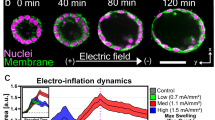Abstract
It is commonly believed that the cochlea emits sounds through backward-traveling waves. In the present experiment using a scanning-laser interferometer, I detected forward-traveling but not backward-traveling waves and found that the stapes vibrates earlier than the basilar membrane. These results contradict the current theory and show that the ear emits sounds through the cochlear fluids as compression waves rather than along the basilar membrane as backward-traveling waves.
This is a preview of subscription content, access via your institution
Access options
Subscribe to this journal
Receive 12 print issues and online access
$209.00 per year
only $17.42 per issue
Buy this article
- Purchase on Springer Link
- Instant access to full article PDF
Prices may be subject to local taxes which are calculated during checkout


Similar content being viewed by others
References
Kemp, D.T. Hear. Res. 22, 95–104 (1986).
Probst, R., Lonsbury-Martin, B.L. & Martin, G.K. J. Acoust. Soc. Am. 89, 2027–2067 (1991).
Shera, C.A. & Guinan, J.J. Jr. J. Acoust. Soc. Am. 105, 782–798 (1999).
Knight, R.D. & Kemp, D.T. J. Acoust. Soc. Am. 109, 1513–1525 (2001).
Robles, L., Ruggero, M.A. & Rich, N.C. J. Neurophysiol. 77, 2385–2399 (1997).
Ren, T. Proc. Natl. Acad. Sci. USA 99, 17101–17106 (2002).
Cooper, N.P. & Rhode, W.S. J. Neurophysiol. 78, 261–270 (1997).
Rhode, W.S. J. Acoust. Soc. Am. 49 (Suppl. 2), 1218–1231 (1971).
Khanna, S.M. & Leonard, D.G. Science 215, 305–306 (1982).
Russell, I.J. & Nilsen, K.E. Proc. Natl. Acad. Sci. USA 94, 2660–2664 (1997).
Narayan, S.S., Temchin, A.N., Recio, A. & Ruggero, M.A. Science 282, 1882–1884 (1998).
Olson, E.S. Nature 402, 526–529 (1999).
von Békésy, G. Experiments in Hearing (McGraw-Hill, New York, 1960).
Zwislocki, J.J. J. Acoust. Soc. Am. 25, 986–989 (1953).
Acknowledgements
I thank A.L. Nuttall, P. Gillespie and K. Grosh for comments on an earlier version of the manuscript, E.V. Porsov for writing software, and S. Matthews for technical help. Supported by the National Institute on Deafness and other Communication Disorders (NIDCD), and the National Center for Rehabilitative Auditory Research (NCRAR), Portland Veteran's Administration Medical Center.
Author information
Authors and Affiliations
Corresponding author
Ethics declarations
Competing interests
The author declares no competing financial interests.
Supplementary information
Supplementary Fig. 1.
Diagram of the widely accepted theory of the propagation of the cubic distortion product otoacoustic emission in the cochlea3,4,5. (a) Waveforms and envelopes of basilar membrane (BM) vibration at f1, f2, and 2f1 - f2; (b) corresponding phase curves. The acoustic energy at distortion product (DP) frequency of 2f1-f1 is generated near "DP origin" and propagates in both directions along the BM. The backward traveling wave vibrates the stapes and appears as the emissions in the ear canal. The forward-traveling wave is partially reflected near DP characteristic frequency place (DP CF) and forms a second backward traveling wave. The phase of the backward traveling waves shows a positive relationship with the distance from the base. (JPG 45 kb)
Supplementary Fig. 2.
Cochlear fluids-based mechanisms for the transmission of the otoacoustic emission in the cochlea. (a) Waveforms and envelopes of BM vibration at f1, f2, and 2f1 - f2; (b) corresponding phase curves. The acoustic energy generated near "DP origin" propagates through the cochlear fluids to the whole cochlea at the speed of sound in water. It vibrates the stapes, resulting in emissions in the ear canal, and launches a forward traveling wave at 2f1 - f2. Thus, in panel b, the backward propagation of the emission shows no significant phase delay. (JPG 44 kb)
Rights and permissions
About this article
Cite this article
Ren, T. Reverse propagation of sound in the gerbil cochlea. Nat Neurosci 7, 333–334 (2004). https://doi.org/10.1038/nn1216
Received:
Accepted:
Published:
Issue Date:
DOI: https://doi.org/10.1038/nn1216
This article is cited by
-
A chemo-mechanical cochleostomy preserves hearing for the in vivo functional imaging of cochlear cells
Nature Protocols (2023)
-
Distortion Product Otoacoustic Emissions in Mice Above and Below the Eliciting Primaries
Journal of the Association for Research in Otolaryngology (2023)
-
Bandpass Shape of Distortion-Product Otoacoustic Emission Ratio Functions Reflects Cochlear Frequency Tuning in Normal-Hearing Mice
Journal of the Association for Research in Otolaryngology (2023)
-
Cochlear motion across the reticular lamina implies that it is not a stiff plate
Scientific Reports (2022)
-
The reticular lamina and basilar membrane vibrations in the transverse direction in the basal turn of the living gerbil cochlea
Scientific Reports (2022)



